The rapid pace of new development in information technology continues to reshape how businesses, startups, and software developers operate. Keeping abreast of the latest trends is beneficial and crucial for staying competitive. This evolving digital landscape promises exciting opportunities and challenges, highlighting the importance of staying informed about new developments in information technology.
Aloa, with its extensive experience in software outsourcing, stands at the forefront of these transformations. The company’s dedication to harnessing innovative ideas in software development exemplifies its commitment to leveraging modern technologies. Aloa’s proactive approach ensures clients benefit from current technology trends, enhancing business processes and customer experiences across various industries.
This blog offers a deep dive into the new development in information technology, covering everything from generative AI to cloud computing. Afterward, you'll gain valuable insights into how these trends can revolutionize product development, predictive analytics, and more. Prepare to explore how digital transformation, driven by the latest trends in the IT industry, can lead to higher revenues, improved customer service, and robust business leaders prepared for the coming years.
Let’s get started!
Top 8 Cutting-Edge Trends In New Development In Information Technology
The information technology landscape constantly evolves, with breakthroughs and innovations reshaping how we live, work, and interact. Staying abreast of the new development in information technology is crucial for businesses and IT professionals aiming to harness the potential of the digital world.
Here are the top 8 cutting-edge trends in new developments in information technology that are defining the future:
Trend #1: Generative AI and Software Development
Generative AI, a groundbreaking new development in information technology, refers to AI systems capable of creating content autonomously. Generative AI can streamline software development processes by automating code generation and design creation tasks. The driving force behind its growth is the need for faster and more efficient development cycles in response to the increasing demand for software solutions.
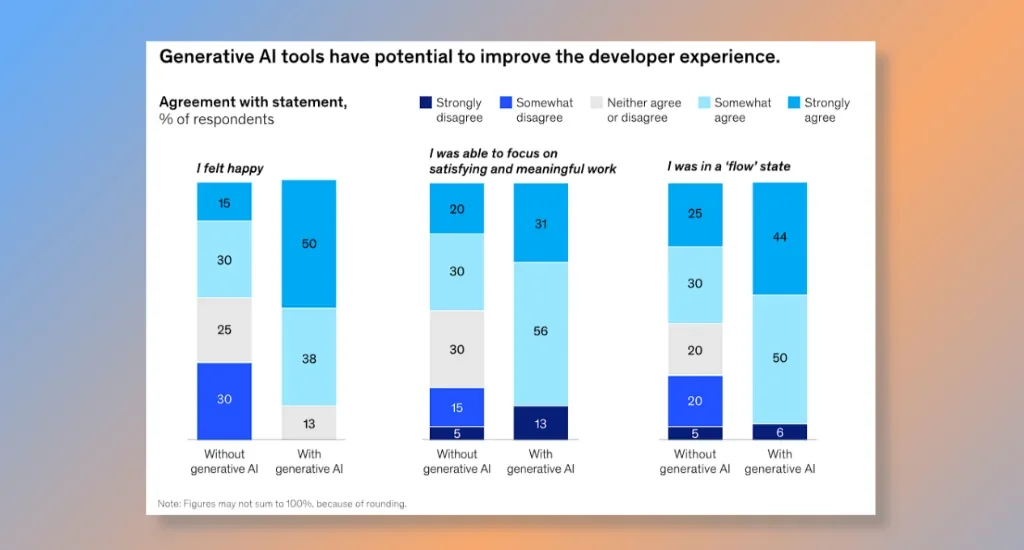
Developers utilizing generative AI tools reported significantly higher happiness, fulfillment, and flow levels. This was attributed to the automation of tedious tasks and quicker access to information compared to traditional search methods.
Impact of Generative AI on Industry
Integrating generative AI into software development processes revolutionizes the industry landscape. In particular, the emergence of generative AI catalyzes shifts across these five key areas:
- Increased Efficiency: Generative AI automates repetitive tasks, allowing developers to focus on more complex challenges.
- Enhanced Creativity: AI-generated content sparks new ideas and innovations, pushing the boundaries of what's possible in software design.
- Improved Time-to-Market: Rapid prototyping and iteration accelerate product development, enabling quicker releases and updates.
- Cost Savings: By reducing manual labor and speeding up development cycles, generative AI helps companies save resources.
- Competitive Advantage: Embracing generative AI gives organizations an edge in delivering innovative solutions and staying ahead of the curve.
Generative AI represents a paradigm shift in software development, offering unparalleled efficiency, creativity, and competitiveness in the industry landscape.
Trend #2: Expansion of IoT (Internet of Things)
The expansion of IoT (Internet of Things), a pivotal new development in information technology, involves connecting various devices to the Internet to enable data exchange and automation. Implementing IoT solutions offers businesses real-time insights into operations, enhances efficiency, and enables the development of innovative products and services. This often includes working with specialized hardware providers such as WellPCB custom cable assembly services, which support reliable connections across smart systems. The driving force behind the growth of IoT is the increasing demand for interconnected devices that can improve processes and user experiences.
.webp)
According to the "State of IoT—Spring 2023" report by IoT Analytics, global IoT connections surged 18% in 2022, reaching 14.3 billion active endpoints. The report anticipates a further 16% growth in 2023, projecting 16.7 billion active endpoints worldwide. Despite a slight dip compared to 2022, the forecast indicates sustained growth in IoT device connections for the foreseeable future.
Impact of IoT on Industry
The widespread adoption of IoT technologies reshape industries in several key ways:
- Enhanced Data Collection: IoT devices gather vast amounts of real-time data, providing valuable insights for decision-making.
- Improved Efficiency: Automation and optimization enabled by IoT streamline processes, reducing costs and resource wastage.
- Innovative Products and Services: IoT facilitates the development of smart products and services that meet evolving consumer needs.
- Predictive Maintenance: IoT sensors enable proactive maintenance, preventing equipment failures and minimizing downtime.
- Enhanced Customer Experience: Personalized, IoT-driven experiences improve customer satisfaction and loyalty.
The expansion of IoT heralds a new era of connectivity and efficiency, empowering businesses to make data-driven decisions and deliver exceptional customer experiences.
Trend #3: Advancements in Big Data and Analytics
Advancements in big data and analytics represent a significant new development in information technology, involving the processing and analyzing of vast datasets to extract valuable insights. Implementing robust big data and analytics solutions allows businesses to uncover patterns, trends, and correlations that drive informed decision-making. The driving force behind the growth of big data and analytics is the exponential increase in data generation across industries, necessitating more sophisticated tools for analysis and interpretation.
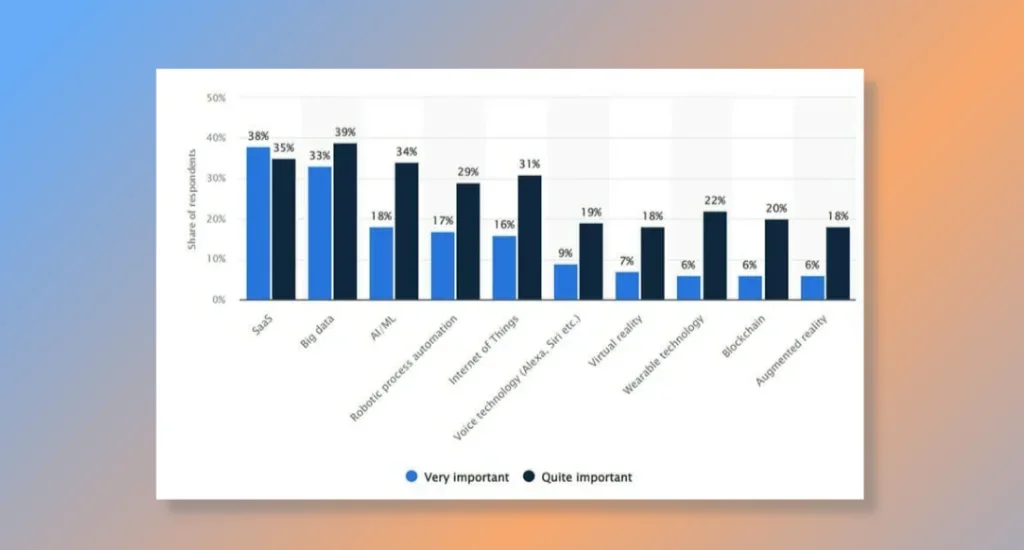
Big data analytics is “very important” for 72% of organizations in reaching business goals, overshadowing SaaS at 73%, with technologies like AI/ML, RPA, IoT, voice, and blockchain deemed important by less than half. Over 160 big data use cases exist globally, with a third of marketers relying on it for advertising, enhancing brand awareness significantly.
Impact of Big Data and Analytics on Industry
Big data and analytics as new developments in information technology revolutionizes how businesses operate and compete in today's data-driven world. Integrating these trends on your businesses enables these five major transformations:
- Data-Driven Decision-Making: Big data and analytics empower organizations to make informed decisions based on real-time insights and trends.
- Improved Operational Efficiency: Big data analytics enhance operational efficiency and productivity by optimizing processes and identifying areas for improvement.
- Enhanced Customer Insights: Analyzing customer data enables businesses to understand preferences and behavior patterns and anticipate needs, leading to more personalized and targeted marketing strategies.
- Predictive Analytics: Predictive modeling and forecasting help businesses anticipate market trends, customer behavior, and potential risks, enabling proactive strategies to mitigate challenges and capitalize on opportunities.
- Competitive Advantage: Companies that harness the power of big data and analytics gain a competitive edge by leveraging insights to innovate, optimize performance, and drive growth.
Advancements in big data and analytics are reshaping industries, enabling organizations to unlock the full potential of their data assets and gain a competitive advantage in the market.
Trend #4: Cybersecurity Innovations
Cybersecurity innovations represent a crucial new development in information technology, focusing on enhancing digital security measures to protect against evolving threats. Implementing advanced cybersecurity solutions is essential for safeguarding sensitive data, mitigating risks, and maintaining trust with customers and stakeholders. The driving force behind cybersecurity innovations is the escalating frequency and sophistication of cyber attacks, necessitating proactive measures to fortify defenses and mitigate vulnerabilities.

On average, households face over 104 monthly threats, with smartphones, computers, tablets, laptops, cameras, and storage devices being the most vulnerable. By 2023, DDoS attacks are projected to reach 15.4 million, while 30% of data issues involve internal actors. Additionally, IoT devices encounter around 5,200 attacks monthly, with many remote code execution attacks associated with cryptocurrency mining. A comprehensive risk management approach can help identify and mitigate IoT risks, effectively addressing security gaps.
Impact of Cybersecurity Innovations on Industry
In the face of increasing cyber threats, cybersecurity innovations play a pivotal role in safeguarding digital assets and preserving the integrity of business operations. Here are essential key highlights to expect:
- Enhanced Threat Detection: Advanced cybersecurity solutions use AI and machine learning to detect and respond to threats in real-time, minimizing the impact of security breaches.
- Improved Data Protection: Encryption and secure authentication methods ensure the confidentiality and integrity of sensitive information, reducing the risk of data breaches.
- Regulatory Compliance: Cybersecurity innovations facilitate compliance with data protection regulations, helping organizations avoid fines and penalties.
- Preserving Trust and Reputation: Proactive security measures protect customer data, maintaining trust among clients, partners, and stakeholders.
- Business Continuity: Effective cybersecurity safeguards against downtime and disruptions, ensuring uninterrupted business operations.
Cybersecurity innovations are paramount in today's digital landscape, enabling organizations to defend against cyber threats, protect critical assets, and uphold trust and confidence in an increasingly interconnected world.
Trend #5: Cloud Migration and Hybrid Cloud Solutions
Cloud migration and adopting hybrid cloud solutions represent significant new developments in information technology, involving the transition of IT infrastructure and services to cloud-based platforms. Implementing cloud migration strategies allows businesses to leverage scalable computing resources, enhance flexibility, and reduce operational costs. The driving force behind cloud migration is the need for agile and adaptable IT infrastructure to support evolving business needs and digital transformation initiatives.
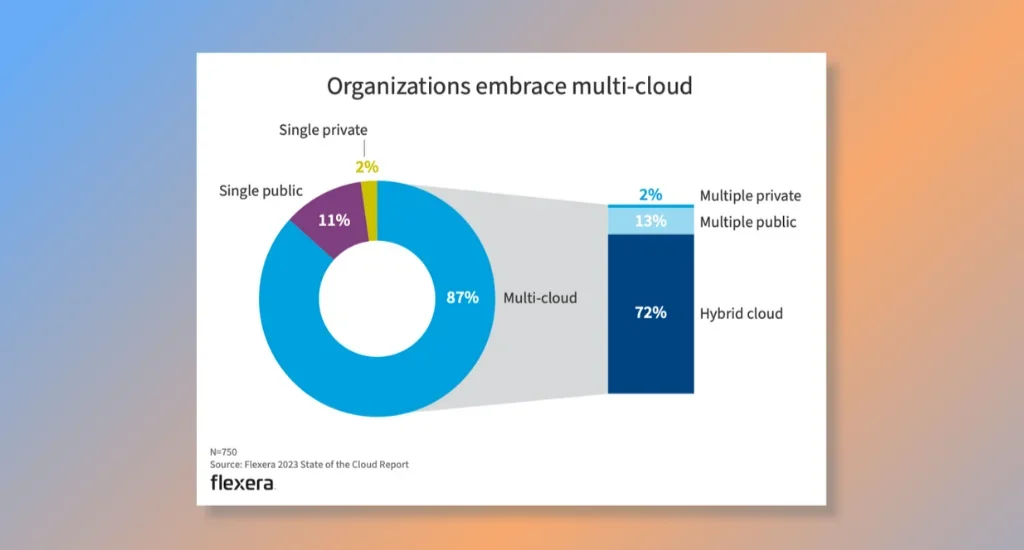
Most organizations still employ a hybrid, multi-cloud approach. However, a slight shift towards single public cloud usage has risen from nine to eleven percent over the past year. Eighty-seven percent of respondents reported adopting a multi-cloud strategy, with 72 percent employing a hybrid approach, integrating both public and private clouds.
Impact of Cloud Migration on Industry
The shift towards cloud migration and hybrid solutions reshape how businesses manage and deploy IT resources in today's dynamic digital landscape. To know whether this trend will highly impact your organization or not, consider these five key highlights:
- Scalability and Flexibility: Cloud-based infrastructure enables agile and cost-effective operations by scaling resources as needed.
- Cost Savings: Cloud migration eliminates on-premises hardware and maintenance costs, offering significant savings.
- Enhanced Collaboration and Accessibility: Cloud-based tools facilitate remote work, improving accessibility and collaboration across distributed teams.
- Innovation and Agility: Cloud-native environments foster rapid application development and deployment, promoting innovation and agility.
- Disaster Recovery and Business Continuity: Cloud-based solutions ensure data resilience and continuity, mitigating potential disruptions and downtime.
Cloud migration and hybrid cloud solutions drive transformative change across industries, enabling businesses to embrace agility, innovation, and resilience in an increasingly digital-centric world.
Trend #6: AR and VR Technologies
Augmented Reality (AR) and Virtual Reality (VR) technologies are pioneering new developments in information technology, revolutionizing how users interact with digital content and immersive experiences. Implementing AR and VR technologies allows businesses to create engaging simulations, training programs, and virtual environments that enhance user engagement and comprehension. The driving force behind the growth of AR and VR technologies is the increasing demand for immersive and interactive experiences across various industries, from gaming and entertainment to education and healthcare.

Goldman Sachs predicts the industry could reach $80 billion by 2025, with diverse potential in software ($35 billion) and hardware ($45 billion). While gaming is a promising use case, live events and video entertainment also feature prominently in consumer applications. However, the potential of AR/VR extends beyond the consumer sphere. Goldman Sachs suggests nearly half of the industry's revenue will come from the enterprise and public sectors, highlighting healthcare and engineering as promising areas for utilization.
Impact of AR and VR Technologies on Industry
These new developments in information technology are reshaping user interactions and experiences, offering unprecedented opportunities for innovation and engagement across industries. Here are the five key impacts and breakthroughs to watch out for:
- Enhanced User Engagement: AR and VR technologies captivate users, driving engagement with digital content.
- Training and Education: AR and VR simulations facilitate experiential learning and skill development.
- Virtual Product Prototyping: AR and VR enable businesses to create virtual prototypes, reducing time-to-market.
- Healthcare and Telemedicine: AR and VR enhance medical training, patient education, and remote diagnosis.
- Entertainment and Gaming: AR and VR gaming experiences push the boundaries of interactive entertainment.
AR and VR technologies are unlocking new possibilities for innovation and engagement across industries, offering immersive and interactive experiences that enhance learning, entertainment, and collaboration in the digital age.
Trend #7: Robotic Process Automation (RPA)
Robotic Process Automation (RPA) is a transformative new development in information technology involving automating repetitive tasks and processes using software robots or "bots." Implementing RPA solutions allows businesses to streamline operations, improve efficiency, and reduce human error. The driving force behind the growth of RPA is the increasing demand for automation solutions that can enhance productivity, reduce costs, and free up human resources for more strategic tasks.
.webp)
In 2019, 40% of companies adopted automation. Over 50 RPA providers existed globally, with more expected. By 2020, 90% of enterprises aimed to use RPA, while automation and AI were predicted to cut 65% of shared service jobs. RPA's potential impact by 2025 was estimated at $5-7 trillion, with 1 in 10 startups leading in digital workforce integration.
Impact of RPA on Industry
Robotic Process Automation (RPA) as the new development in information technology revolutionizes business operations by automating repetitive tasks and processes, driving industry efficiency and productivity. Some essential key impacts of this trend are as follows:
- Process Automation: RPA solutions streamline repetitive tasks like data entry, form processing, and report generation, minimizing errors.
- Improved Efficiency: RPA optimizes processes, freeing human resources for strategic tasks and accelerating operations.
- Cost Reduction: RPA cuts labor costs, enhances accuracy, and reduces manual intervention, saving time and money.
- Scalability and Flexibility: RPA systems adapt to automate tasks across departments and functions, ensuring scalability.
- Enhanced Compliance: RPA enforces standardized processes, reducing human error and ensuring regulatory compliance.
RPA transforms business operations by automating repetitive tasks, driving efficiency, and enabling organizations to achieve greater productivity and compliance across diverse industries.
Trend #8: Cloud Computing
Cloud computing is a revolutionary new development in information technology, offering on-demand access to computing resources such as servers, storage, and applications over the internet. Implementing cloud computing solutions enables businesses to scale infrastructure dynamically, reduce capital expenditures, and improve operational agility. The driving force behind the growth of cloud computing is the need for scalable, flexible, and cost-effective IT solutions to support digital transformation initiatives and business growth.
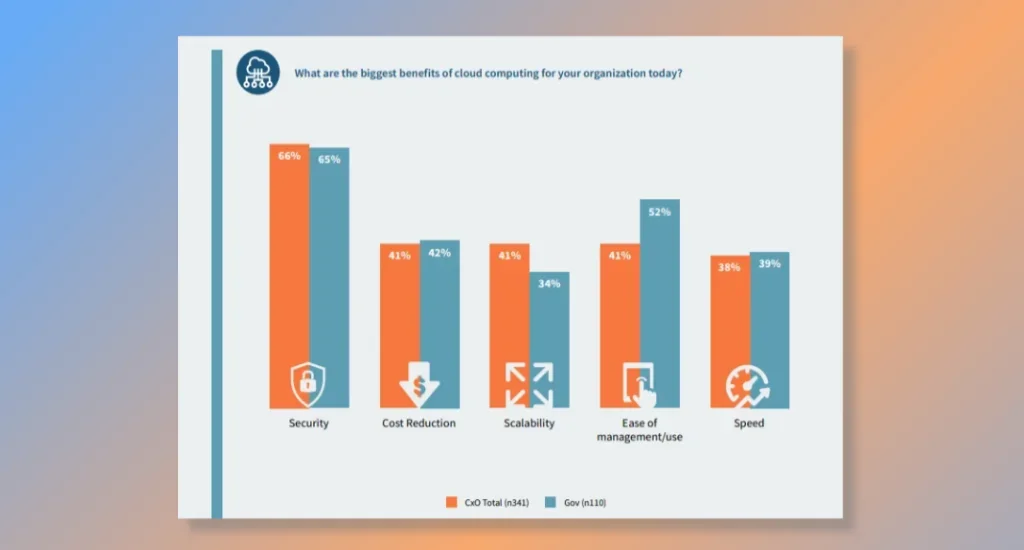
The chart shows the benefits of cloud computing for organizations, with security being the top benefit at 66% for CxO Total (341 respondents) and 65% for Government (110 respondents). Cost reduction and scalability are seen as benefits by 41% of both groups, while ease of management/use is recognized by 41% of CxO and 34% of Government. Speed benefits 38% of CxO and 39% of the Government.
Impact of Cloud Computing on Industry
This new development in information technology is reshaping how businesses deploy and manage IT infrastructure, offering unprecedented scalability, flexibility, and cost-efficiency. Let’s delve deeper into its key aspects below.
- Scalability: Cloud computing enables businesses to scale resources based on demand, ensuring cost-effectiveness.
- Cost Efficiency: Cloud computing reduces IT costs by eliminating upfront investments in hardware.
- Agility and Innovation: Cloud-native environments foster rapid innovation and deployment.
- Accessibility and Collaboration: Cloud-based tools facilitate remote work and seamless collaboration.
- Disaster Recovery and Business Continuity: Cloud-based solutions ensure data protection and continuity.
Cloud computing is revolutionizing how businesses deploy, manage, and scale IT infrastructure, offering unparalleled scalability, flexibility, and cost-efficiency to support digital transformation and drive innovation across industries.
How to Stay Ahead of the Curve In New Development In Information Technology
Staying ahead of the curve is crucial for professionals looking to maintain their relevance and competitive edge. With the new development in information technology emerging at a breakneck speed, understanding and adopting these innovations can significantly impact your professional standing and operational efficiency.
Here, we dive into five key strategies to effectively navigate and leverage the top information technology trends.
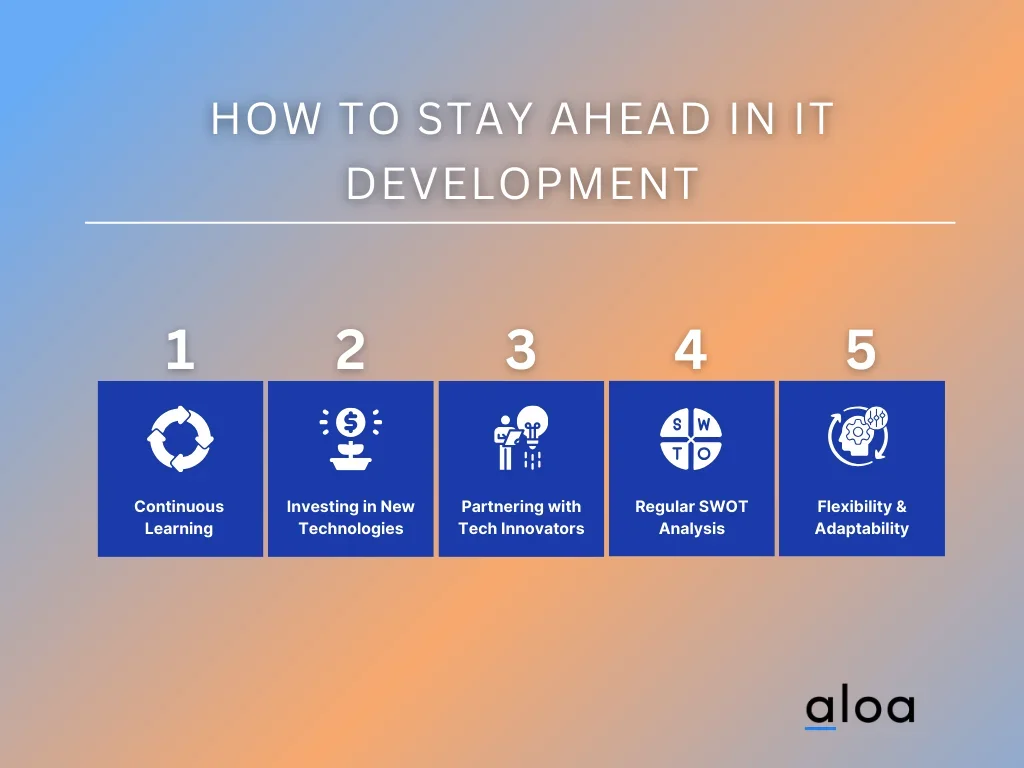
Continuous Learning and Training
The digital world is constantly evolving, with AI in software development leading the charge as a prime example of how rapidly technologies can transform industries. For IT professionals, embracing continuous learning is essential. Engaging with new software frameworks, exploring the capabilities of big data, and understanding the intricacies of AI and data science are pivotal. Hiring AI developers or investing in training for current staff ensures that your team remains adept at deploying the latest tech trends, from generative AI to cloud migration strategies.
Investing in New Technologies
To stay ahead, investing in emerging technology in business is not just an option; it's a necessity. This includes adopting IoT (Internet of Things) for enhanced data processing and leveraging AR technologies for more immersive customer experiences. In recent years, technologies like virtual reality and robotic process automation have revolutionized the gaming industry to supply chain management, demonstrating the vast applications and market growth potential of new technologies.
Partnering with Tech Innovators
Collaboration with pioneers in the IT sector can provide a significant advantage. Whether it's cloud migration to manage large volumes of data more efficiently or employing low code platforms for quicker application development, partnering with experts can accelerate your adoption of new trends. This approach enhances your capabilities in handling big data, improving data storage solutions, and navigating the complexities of digital transformation in remote locations or centralized data centers.
Conducting Regular SWOT Analysis
Understanding where your organization stands regarding strengths, weaknesses, opportunities, and threats in the current information technology industry is vital. Regular SWOT analyses can help identify potential upgrades, foresee production issues, and align your IT strategy with the growing trend of intelligent machines and the broader digital transformation. This proactive measure ensures you keep up with information technology trends and position yourself to capitalize on them effectively.
Embracing Flexible and Adaptive Strategies
The information technology landscape constantly changes, with new developments swiftly rendering previous innovations old news. Adopting flexible and adaptive strategies, such as exploring various mobile internet applications or considering the impact of AI on credit risk assessment in financial institutions, is crucial. This mindset allows businesses to quickly pivot in response to the latest tech trends, from advancements in data science and the IoT to the increasing reliance on customer data for personalized services.
Key Takeaway
Staying ahead requires an unwavering commitment to embracing the new development in information technology. The essence of sustained success lies in adapting to these advancements and profoundly understanding their impact and potential. Startups, businesses, and software developers must remain informed about the latest developments in information technology. This knowledge is a cornerstone for innovation, efficiency, and competitive edge.
Aloa stands at the forefront of this journey, dedicated to offering valuable insights and resources that empower businesses to navigate the complexities of the IT sector effectively. We encourage you to explore our blogs, where we delve deeper into specific trends, providing a richer perspective on the new development in information technology. This commitment underscores the importance of staying updated and leveraging these insights for strategic decision-making and growth.

